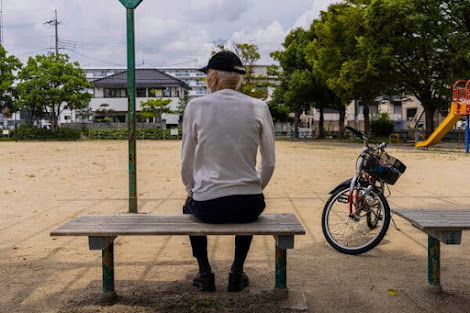Digital eyes on the elderly. Electronic surveillance is used to address Japan's epidemic of dementia.
Itami is one of the several locaities that have turned to electronic tracking as Japan, the world's grayest nation, confronts an epidemic of dementia.
The programs offers the promise of protecting those in cognitive decline while helping them retain some independence, but they have evoked fears of Orwellian overreach.
The Japanese government sees the task as critical to the country's future stability, envisioning fundamental changes to nearly every aspect of society, including education, health care and even, as in Itami, infrastructure.
The surveillance system there is one of the more extreme examples of this adaptation.
Advocates for people with dementia, including some with the condition itself, have raised serious concerns about digital tacking, warning that the convenience and peace of mind offered by surveillance could threaten the dignity and freedom of those being monitored.
Japanese people are intensely protective of their personal privacy, and many municipalities have adopted less intrusive forms of electronic tracking.
As with any tool, the value of the Japanese system will ultimately be determined by how they are used., said Kumiko Nagata, the lead researcher at the Tokyo Dementia Care Care Research and Training Center.
She sees promise in applications that give users more freedom by relieving fears that they will get lost. But she worries that the systems will ''just be used as tools for dealing with 'problem' people'' - anyone who has become a burden on a family or officials.
As the nation with the world's oldest population, Japan is most vulnerable to the ravages of dementia : memory loss, confusion, slow physical decline and, most heartbreakingly, the ineluctable dissolution of the self and relationships with others.
Japan has the world's highest proportion of people with dementia, at about 4.3 percent of the population, according to an estimate by the Organization for Economic Cooperation and Development in Paris.
A 2012 Japanese government study found more than 4.62 million residents with dementia, and some researchers estimate that a quarter of the Japanese population will have the condition by 2045.
Dementia is the leading cause of missing-person cases in Japan.
More than 17,000 people with dementia wandered off in 2020, up from 9,600 in 2012, the first year of official data was reported.
Some localities have turned to low tech solutions, such as key chains with instructions on how to help those who are lost.
But as more people with dementia live at home, digital solutions have become more alluring.
Those range from the more intrusive, such as security cameras and tracking devices that can be slipped into a shoe, to more progressive options like QR codes that can go on a fingernail and alert caregivers when scanned.
Although localities and companies have made large investments in developing and promoting the programs, they remain sparsely used in part because of ethical concerns.
The problem of informed consent in particular is a tricky one, especially in cases where it can be difficult to assess whether a person with dementia is capable of giving it.
The registration process for the systems is typically initiated by caregivers, and only as a last resort. Medical professionals then evaluate prospective surveillance candidates. They are not required to notify the individuals themselves.
Take, for example, the city of Takasaki in central Japan, which introduced its own GPS tracking system in 2015. Much like their peers in Itami, caregivers there can unilaterally share their wards' photos and give the police permission to get access to their location data.
Itam's mayor, Yasuyuki Fujiwara, said that when he first proposed a surveillance program he was ''worried about the perception that we would be spying on private citizens.''
Mr. Fujiwara initially pitched the idea as a tool for stopping crime and keeping an eye on children as they walked to school. Before long, cameras began popping up citywide, their locations chosen with public comment.
In 2015, the city opened the program to the families of the older people prone to wandering.
The cameras themselves don't track people. They are equipped with receivers that communicate with small beacons carried by those enrolled in the program. When the bearer of a beacon passes by, the device records the person's position and sends it to a smartphone app that an authorized caregiver can check.
Mr. Fujiwara offered assurances that the data could be viewed only by the family. Still, only 190 older people used the program last year, while nearly half of all elementary school students in the city of 200,000 were registered.
The Publishing continues. The World Students Society thanks authors Ben Dooley and Hisako Ueno.

.png)


0 comments:
Post a Comment
Grace A Comment!